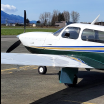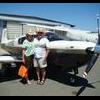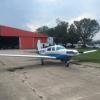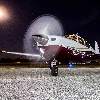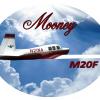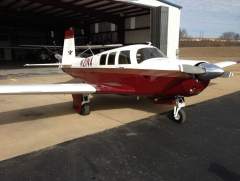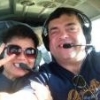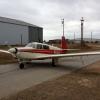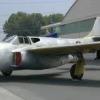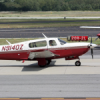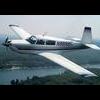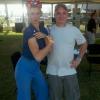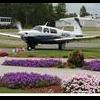Leaderboard
Popular Content
Showing content with the highest reputation on 05/30/2013 in all areas
-
It's entirely a mission question. I primarily fly long X/Cs. 99.9% of the time I'm working out weather problems, not AOA problems. For 6+ months of the year, those weather problems involve convective activity. An AOA in my scan isn't ever necessary, but I acknowledge it would be helpful in certain situations. In contrast, during the summers, a stormscope in the scan is generally very helpful for getting a better weather picture, and occasionally necessary for determining a safe route of flight. I'm not knocking AOAs, and can see their utility, but having flown floats in the bush where weight and power issues are far less theoretical than they are for most GA flights off runways, I think you can be just as safe relying on airspeed, provided you know how your plane operates at different attitudes and power settings, and fly conservatively within that envelope.3 points
-
I would encourage you to do long cross countries, that is what flying is all about. Just make sure the weather is OK. You will be surprised how far you can go VFR. You are never going to learn to fly reading a book. Not that I'm discouraging you from learning all you can, but the only way to make sense of it all is to get out there.3 points
-
I think I would have help if in this poll the type of engine and oil used was included. Different viscosities and brands have different rate of consumption. José2 points
-
I fly for a part 91 corporate flight department and am a captain on a Falcon 900B. I also do part time work for a part 135 flight department and am a captain on a Lear 31A/Lear 35A. I'll keep it short as a lot of great points have already been made so I'll just add to them instead of repeating what was already said. Do you feel that your professional decision making and safety carries over to your private operations? How and why? Absolutely. First of all, we are in the simulator every six months reviewing instrument procedures and at the same time dealing with multiple abnormals and emergencies in the equipment we fly. So it is inevitable that we are going to be more proficient. In addition we are out working the system and making decisions almost daily. Exercising that thought process in our “9 to 5” job will undoubtedly transfer into our personal flying. I would recommend that folks do more recurrent training with an instructor that will put your through the paces both in equipment failures and instrument proficiency. If you could pick only a single safety aspect of commercial flying that can greatly improve GA safety record, what would that be? There always has to be an “out” or “plan B & C”. There is nothing left to chance. If there is then you have just done yourself and your passengers a huge disservice.2 points
-
Good questions. From the military test pilot perspective my profession has profoundly influenced by GA (part 91) flying. how do you contend with part 91 operations in your personal Mooney? - I apply the same discipline to part 91 ops as I do with all my flying. Why? The stakes are just as high - my ass and reputation is on the line. Whether its at 160KIAS in a Mooney or 650KIAS+ in full AB. Aviation, by its nature, is unforgiving and leaves little room for carelessness and lack of judgement. Do you feel that your professional decision making and safety carries over to your private operations? How and why? - Now you're getting to the sole of the matter. Decision making. Part 91 allows more freedom by design, but what many pilots don't realize the responsibility for safe operations rests solely with the PIC. 121/135/military/test flying etc all operate within more rigid systems. Rules, regs, company policy, etc are in place to assist the PIC with his decision making, which in many ways help make the decision for him. Larger the professional operation the more checks and balances in place. - I realize that part 91 can be some of the most dangerous flying I've done. (what? your a combat aviator, test pilot and 91 is dangerous?). Let me explain. Part 91 I'm 'outside the system' on my own. Freedom! But with freedom comes personal responsibility. So I'm very conservative flying my Mooney since not only my ass is on board but in many cases also my wife and daughters. By conservative I mean I fly within my airplane (and my limits) realizing that I don't have to reach my destination on time, but I must ensure I bring the flight to a safe conclusion. Decision making and risk management. Failing to know your limits, fly within the rules, and apply solid decision making are the weakest areas of part 91 ops. A big part of that is failing to understand what it really means to be PIC. The beauty of part 91 is YOU (the PIC) shoulder more of the burden than any other category of operation. What aspects of commercial flying have you brought back to private operations that make you safer? If you could pick only a single safety aspect of commercial flying that can greatly improve GA safety record, what would that be? - Again, decision making and risk management. Key enablers to those are training, experience, knowing your aircraft systems and capabilities, and seriously considering the potential risks of your planned mission while working to minimize those risks. Make a GO/NO-GO decision on the ground and then continually use the tools at your disposal, as PIC, to re-evaluate that decision. Professional pilots approach all their flying with the same rigor, discipline, and respect. As a wise, old J-3 pilot once told me. "Just because this old airplane is slow never take it for granted and let your guard down cause she's just fast enough to kill you". Your most valuable tool as a pilot are your decision making skills.2 points
-
If I was flying my husky into a 600 ft obstructed glacier runway while hanging on the prop like Doug Geeting of Talkeetna Ak...an aoa over a storm scope could make sense.But I donot fly into glaciers very often(I did it once)I do how ever fly IMC quite a bit..since my Mooney doesnt have onboard radar my stormscope in cell mode along with the 5 min old XM nexrad is all Ive got to confirm a bumpy cumilo nimbus.Where there is lighting ,there I am not.Not having an AOA in the Mooney I do not miss at all.I once owned a maule m5 with a safeflight aoa that I nevered used simply because when you are low and slow with the stall warner blaring in the background,the last thing you are looking at is any panel mounted instrument.My attention was completely taken up by trees and rocks,wind riffles on water and screaming passengers.1 point
-
I'm an attorney familiar with these issues. If anybody wants my cell phone number to put in their phone, send me a PM. I don't want to post it in the public search-able forum, but I'm happy to give it out to fellow pilots. If you ever find yourself accosted by Homeland Security, the FBI, Border Patrol, or anybody else, ask to call an attorney, and call me. No charge. Attorneys, including me and those hired by the AOPA, cannot post general guidance for what to do. It's not smart or even legal to give generalized legal advice like that. But if you get me on the phone, I can advise you for your current situation, and I would be happy to. If it results in a few more pilots exercising their constitutional rights in a smart, respectful manner, it will be time well spent.1 point
-
Because my vRef between fully loaded and almost empty is about 5knots, I do not see any value what so ever in an AOA. Unless flying into a runway less than 3500feet, if I simply use 80knots on final, I'm set. What is an AOA going to do for me? Stormscope on the other hand has saved my bacon more than once. AOA makes sense in 'real' airplanes where the vRef can be all over depending on the weight.1 point
-
Without an AOA, airspeed indicator works fine. Without a stormscope, on-board radar is the only substitute for "real time" storm info. I'm not "dissing" your love affair with an AOA, but I fly planes with AOA and indexer lights and rarely refer to it except during stall practice in the sim. Just not that vitally important for routine ops. However, a stormscope will answer that all important question: "Can I safely go into this cloud?" AOA, or stormscope? Stormscope first, everytime. .1 point
-
Not sure about the thread, but I recommend Wash-Wax-All. Works great, can do it in the hangar without a hose or floor drain, and it makes bug removal fast and easy. Visit www.washwaxall.com, I think. Blue is for everything, Red works well if the belly gets nasty.1 point
-
I remember when that came up for sale a while ago... I got the impression it had been sitting for a while after the owner passed. It looks like a good starting point for someone that wants an Ultimate E Speedster with that J engine, windscreen, and LoPresti Cowl. It of course needs a cosmetic overhaul and panel modernization, but it is off to a good start.1 point
-
I would disagree with jlunseth and would recommend doing the instrument and commercial together. Why? because that's what I did! But seriously, there is a lot that you can learn in the commercial syllabus, and it will make you a better pilot under VFR and IFR. While I agree that the chandelles and lazy 8s are fun, along with the other commercial maneuvers, I also believe they make us better pilots. The commercial standard is designed to give you a better feel for what the plane is capable of and it will improve your stick and rudder skills. While some folks claim that the commercial maneuvers have little or no application in day to day flying, they can and will save your bacon in the event that you need to be familiar with those boundaries. The emergency descent alone is worth the price of admission in my opinion. You could have used it instead of pummeling near VNE down through a "hole" in the clouds.1 point
-
With the type of commercial aviation that I am involved in there is nobody else involved once the plane is handed over to me. The part 135 ops I have been involved with come with "green" copilots who generally have less than 1000 hours. So I can't say that a 2 person crew has helped me in the part 135 arena. Now with the corporate part 91 flight department I have always had an equally competent Co-Captain to fly with and that surely makes it "easier" but not necessarily safer. I have never had the opportunity to work with a "support" ground crew (dispatcher, staff meteorologist, etc), everything I have been involved with has been up to me or us (crew) so I can't speak to the benefits of them. Again Mike, IMO, recurrent training, proficiency and proper planning are key ingredients to any safe operation. If you can't look your passengers in the eyes and tell them that no matter what happens during this flight that their safety (survivability) is assured, then the trip should be a no go. You have looked at every realistic scenario for the route and conditions to be flown and concluded that it can be done with nothing to chance (meaning you have a plan for multiple contingencies that have a safe outcome) then you are operating professionally and safely. Just one of many accidents that with the proper planning and a known "out" that could've been avoided. I was flying this night and was scheduled to leave Toronto and take pax to PHL and then to PIT. I was given the trip about 2pm in the afternoon and it was scheduled to be in PHL around 7pm then onto PIT. I looked at the forecast and immediately declined the leg to PHL as it was forecasting to be close to minimums and possibility of below minimums and nothing close to PHL was forecasting any better. http://delaware.newszap.com/centraldelaware/119571-70/faa-finds-fuel-emergency-before-fatal-dover-plane-crash1 point
-
I'm guessing a quart every 10 hours or so when it settles down to 6 qts. If I'm higher than 6-6.5 qts, it blows out pretty fast.1 point
-
Figures I'll be in Bah Hobba (Bar Harbor). I would like to get together with some of the Mooney crowd soon!!1 point
-
Thank you so much, Zane, JimR, Hank, and Oscar. I believe that I have locked in a retired airline captain and local (Kansas City area) CFI for the ferry mission, as well as for my initial insurance-required dual instruction in make and model. I’m just waiting for final confirmation from him. Many happy landings! :-) Thanks again, Bobby1 point
-
This company has any part or kit you need for them. http://www.avstardirect.com/store/fuelinjection1 point
-
I always liked this wyoming windsock picture: http://www.tripadvisor.com/LocationPhotoDirectLink-g60503-i38336851-Laramie_Wyoming.html1 point
-
I am not the only one who has had trouble with calibrating an AOA instrument. A quick search on the internet this morning found a couple of pilots who had calibration problems. In one case, the probe had to be modified, and in another case, the angle of the probe had to be changed. I suspect that the calibration instructions are more generic than specific to particular airframes. The Alpha site shows a Cirrus specific plate for their unit, and I would be much more interested in a Alpha system if they made a plate that exactly matches one of our under wing inspection plates, and then extensively tested the functioning of their system. Two pilots reported mounting their probes in the same location - under wing (high wing Cessnas), out of the propeller airstream, and one had problems with calibration, the other did not. Both liked the units, once everything was setup.1 point
-
I fly part 135 helicopter ops for the oil and gas industry, In our IFR program we maintain the same safety statistics as the major airlines, and I agree with what is being said by the professionals so far. I love the 1000 hours versus 1 hour flown 1000 times analogy. We have a lot of overlap with fixed wing part 121/135 ops as far as operations go. I think we also have a lot of overlap with the GA pilots as far as resources available, which can be limited at best. While we do have the cockpit resources; We have to deal with a pretty dynamic environment as far as weather and often compromised landing locations with lots of obstructions, the remote locations mean little help from ATC, and we are often one way fuel. (we do have alternates though}...just to name a few things. Think Bush flying mixed with Flying a business jet. The question of what is different between a commercial operation as opposed to what can a GA guy do are sort of two different animals. . here is my 2 cents on what a GA pilot can do to model their flying after a commercial operator, keep in mind i am generalizing here for the sake of shall we say confirmation, that you are already doing things that many professional operators demand from their pilots. 1. Read the regs that apply to part 135/121 and apply those rules to your own flying at a minimum. taking off Zero Zero is legal part 91, but for part 135 we are limited to what we can come down to, if those limits are the minimum for a two pilot crew with more resources, that might be a more realistic starting point to work up from as far as personal minimums flying SPIFR. 2. Make everything you do into a procedural operation, and back it up with a checklist, in other words, fly the way you would with the FAA onboard. For critical items, read it and do the item line by line as you go. I find the POH checklist to be pitiful crude guidance, which puts GA pilots in pinch where they have to make up for the inadequacies on thier own. I made my own checklist to fill in a lot of the blanks in my flight regime, it is modeled after the ones I use at work and the ones you would find at flight safety or CAE. Checklists are the cornerstone of good SOP's and accidents are often attributed to departure from SOP's. Always use checklists, as in have it out and be reading it, dont just mentally reference it...they really shine when the weather forecast is bust, and you are like everyone else trying to get down the approach on the ground, and you are tired after a long flight. Because the radio will be busy, the ride will be bumpy and those are the times when you forget to properly set something up correctly, sometimes its the little things that can be the most insidious. here is mine for reference, it is tabbed so that you can just put your thumb on the tab and flip to the page. http://mooneyspace.com/gallery/image/34171-/ 3. Strive to manage workload and be ahead of the aircraft- Set things up well in advance, and do it when your workload is lower. If you start cramming in cockpit chores that you could have had done, you lose situational awareness. which is often attributed the start of the chain of events that lead to an accident. the farther ahead you can be, generally the better. 4. fly conservatively and make conservative decisions- It may be a common misconception that professional pilots are the sky equivalent to race car drivers, capable of routinely pushing thier machine to the limits all in the name of profits, but I think the average guy would be surprised at how conservative and methodical things are on a professional flight deck. Weather radar is used to avoid things by a healthy margin, not to see how close you can get. Use what resources you have accordingly. the best philosophy is avoidance of bad weather. The most conservative decision is the best one. If you have to fly at night 5. Practice flying the same way everytime, all the way.- when you go out and practice traffic patterns or approaches, they should be dead standard. Fly the full approach at the speed you would fly it were real. A lot of guys rush around, bouncing from approach to approach for practice, this leads to cutting corners and an inaccurate mental picture of how the approach should go. 6. It is asinine to fly airplanes without an Instrument rating- Probably not a real common problem here on mooneyspace given the mission profile of the plane, I would expect the majority here have instrument ratings but if you dont have one, before you do anything else, go out and get one and commit to using it frequently. Having it "just in case" and then only getting recurrent on an IPC ride is unwise. it is very dangerous, because a pilot can think they can rely on it to get them out of a jam, and in all reality they are in no position to be using it at that point, they are perishable skills. again probably more advise for the guys who fly brand C and P on the weekends to go get a hamburger, but all the same, it applies. 7 Train and practice- as mentioned currency is big. Basic airman-ship is important, don't let the autopilot do everything for you, handfly often, those skills are also very perishable. Fly conservatively in the traffic pattern, and hold yourself to a high standard. Fly with a CFI every now and then who you trust. You may have developed some little habit pattern that needs correcting. Good airmanship leads to being able to do what you should be doing in terms of maintaining situational awareness, by being "outside of the airplane in VFR weather and being able to plan well ahead in IFR weather, becuase managing the aircraft is second nature.1 point
-
Well Bob, when I was chasing a randomly popping gear breaker, I got to be quite a good breaker observer. Caught my eye before I saw anything else!1 point
-
Just a comment. An AOA instrument is only as good as its calibration. Most of the AOA units have a specific methodology for calibration, and this should be followed to the letter, and checked several times. I had an AOA in my DOVA D-1, and frankly, I never trusted it because each time I tried to set up the calibration, I got a (slightly) different result - that doesn't breed confidence. If I had panel space near the ASI in my current Mooney, I would probably add one. I will check out some units (again) at Oshkosh, and consider installing one if I make any further panel changes.1 point
-
Hmmm... To summarize: 1. If you would like to use an AOA indicator, then buy one and use it. 2. If you do not wish to use an AOA indicator, then do not buy one nor use one. 3. ...never mind, there's no third option. <sheesh>1 point
-
I often plan and fly 45-60 degrees in the pattern at idle, full flaps, and (sometimes) speedbrakes. Speed? What feels comfortable. AoA? Below stall, using the G-available to turn, not maintain level flight. Is this for the novice? Probably not. Safe? IMO, yes.1 point
-
The cowl flap motor is manufactured BY Globe Motors of OHIO and a replacement can be obtained from them for $850. Takes a couple of days to make one up. The cowl flap can be wired open while you are awaiting the part so that you may continue to fly your a/c. Globe's number is 937-228-3171, web www.globe-motors.com. They didn't take credit cards so COD works. It's expensive, I know, but the problem is solved with an exact replacement.. Good Luck!1 point
-
I have stayed out of this discussion, especially when it degraded almost to the point of "you are an idiot if you don't agree with me." But, it seems that I am so afraid of an unintended stall situation, that I invariably maneuver at some speed which I believe gives me a wide margin of safety. I think it would be helpful if I had a better idea of how much of a margin I have. I know; if I was a better pilot, I wouldn't need that that assurance. If you are plenty confident, and don't think you need an AOA indicator; great. But I'm seriously considering installing one.1 point
-
No its not... The stall vane activates at a certain AOA regardless of airspeed.....it is an angle of attack indicator......1 point
-
1 point
-
Looks like a hollow business plan in order to get Chinese government funding. Do they do that in China also?1 point
-
M20-C's are good 3-person machines; four adults are okay for short flights [1½-2 hours duration] only. Legroom depends on the front seat position; I fly in the middle notch, but unlike in my Honda, I don't scoot the seat further forward when flying. Four burly guys will also require less than full tanks--my one trip that way was limited to 34 gallons, or 4 hours' worth [3 hours + 1 hour reserve]. Fortunately our destination was just under 2 hours away, and I carefully refilled to 17 gallons per side to go back. Can a 172 with four guys actually have useful load left for fuel? Memory says that my initial CFI told me many times that the Skyhawk has 4 seatbelts but won't fly with 4 adults. Another thing: loading baggage into the Mooney is a higher lift, but it's like loading the trunk of your car [although smaller]. Stack stuff right up to the ceiling, then load the back seat if nobody is sitting there. With a Cessna, the door is down low, and it's quite difficult to stack very high unless you crawl in with each bag and throw over the back seat. It all boils down to your mission requirements. How do you plan to load the plane, how often, and how far will you fly it?1 point


